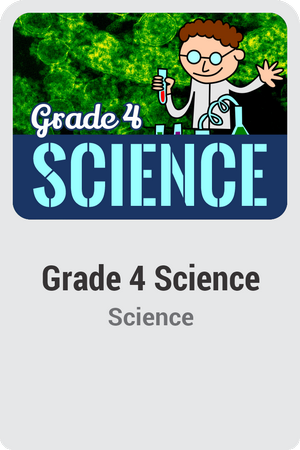
Course Overview:
Science Grade Four is an intermediate course with concepts across many types of sciences, including Earth Science, Life Science, and Physical Science. Through asking questions, making predictions, making and comparing observations, making inferences, working with others to conduct investigations, explaining the results of investigations, developing models, constructing arguments, and making claims, students learn about magnets, motion of objects, energy, properties of matter, physical weathering and erosion, rocks and minerals, plant and animal life, heredity, resources and the environment, seasonal changes, and Earth’s movement.
Prerequisites:
Grade 3 (Recommended)
Required Materials:
Science Basic Materials List
- cell phone to take photos, videos, or audio recordings of student work, or a scanner to scan and submit student work
- coloring materials (crayons, markers, colored pencils)
- storage space on your computer and an external device to back up your files (flash drive, external hard drive, etc.)
- erasers
- general household objects for activities
- glue
- headset or earbuds
- lined paper
- multi-colored paper
- notebook or binder for course resources
- pencils and pens
- printer
- printer paper
- ruler
- scissors
- stapler
- tape
Module Matter
- There are no required materials for this Module.
- There are no optional materials for this Module.
Module Energy Required
- plastic straw
- scissors
Optional
- cardboard pizza box or shoe box
- aluminum foil
- plastic wrap
- tape
- ruler
- utility knife (to be used by a trusted adult)
- pencil
- graham crackers
- marshmallows
- chocolate bars
- oven mitts
- small box
- scissors
- 8 rubber bands
- 2 crayons
Module Motion Required
- 5 coins of the same size (pennies, nickels, dimes, or quarters)
- ruler
Optional
- foam cup
- piece of paper
- ruler
- scissors
- straw
- tape
- 2 thumb tacks
- cardboard tubes
- tape
- recycled household materials such as cardboard tubes, cardboard boxes, foam or paper cups, plastic straws, etc.
- marble
Module Rocks and Minerals
- There are no required materials for this Module.
- There are no optional materials for this Module.
Module Earth's Movement
- There are no required materials for this Module.
Optional
- a foam craft ball
- 2 toothpicks
- 8 chocolate sandwich cookies
- plastic knife
Module Exploring Planet Earth
- There are no required materials for this Module.
- There are no optional materials for this Module.
Module Plants and Animals Required
- paperclip
- scissors
Optional
- pair of old socks
- spray bottle
- water
- tape
- plastic bag
Module The Environment Required:
- scissors
- glue
Syllabus:
Segment One
- Properties of Matter
- Magnets
- Energy
- Motion
- Weathering and Erosion
- Rocks and Minerals
- Scientific Investigations
- Observations
- Science Tools
- Empirical Evidence
- Data Collection
- Science Models
Module 01: Matter
- 01.00 Matter Pretest
- 01.01 Properties of Matter
- 01.02 Mass
- 01.03 States of Matter
- 01.04 Magnets
- 01.05 Changes in Matter
Module 02: Energy
- 02.00 Energy Pretest
- 02.01 Light Energy
- 02.02 Heat Energy
- 02.03 Sound Energy
- 02.04 Electrical Energy
- 02.05 Energy: Science Skills
Module 03: Motion
- 03.00 Motion Pretest
- 03.01 Energy of Motion
- 03.02 Collisions
- 03.03 Speed
Module 04: Rocks and Minerals
- 04.00 Rocks and Minerals Pretest
- 04.01 Physical Properties of Minerals
- 04.02 The Rock Cycle
- 04.03 Weathering and Erosion
- 04.04 Earth’s Changing Surface
- 04.05 Rocks and Minerals: Science Skills
Segment Two
- Earth’s Movement
- Earth’s Resources
- Plant Life Cycles
- Animal Life Cycles
- Inherited Characteristics of Plants
- Inherited Characteristics of Animals
- Producers and Consumers
- Seasonal Changes in Plants
- Seasonal Changes in Animals
- Problem-Solving with Engineering and Design
- Scientific Investigations
- Observations
- Science Tools
- Empirical Evidence
- Data Collection
- Science Models
Module 05: Earth’s Movement
- 05.00 Earth’s Movement Pretest
- 05.01 Rotation and Revolution
- 05.02 Stars
- 05.03 The Moon
- 05.04 Space Research
Module 06: Exploring Planet Earth
- 06.00 Exploring Planet Earth Pretest
- 06.01 Renewable and Nonrenewable Resources
- 06.02 Florida’s Resources
- 06.03 Natural Disasters
- 06.04 Exploring Planet Earth: Science Skills
Module 07: Plants and Animals
- 07.00 Plants and Animals Pretest
- 07.01 Life Cycles of Plants
- 07.02 The Science of seeds
- 07.03 Life Cycles of Animals
- 07.04 Characteristics and Traits
Module 08: Environment
- 08.00 Environment Pretest
- 08.01 Food Energy
- 08.02 Producers and Consumers
- 08.03 Impacts on the Environment
- 08.04 Seasonal Changes
- 08.05 Environment: Science Skills


